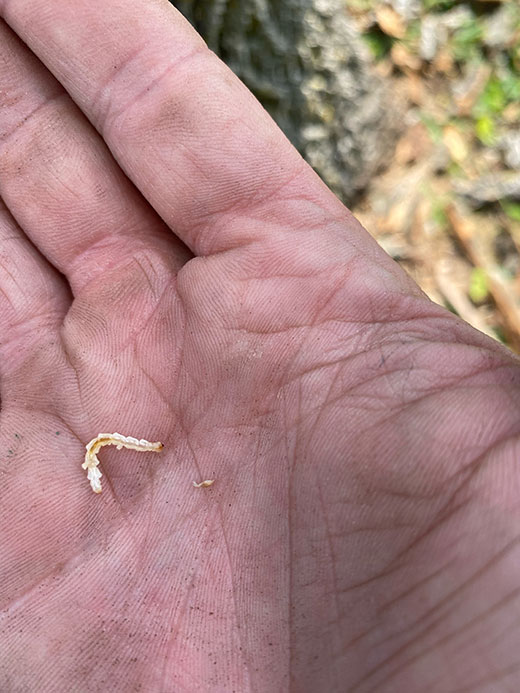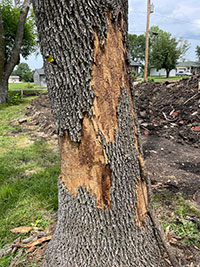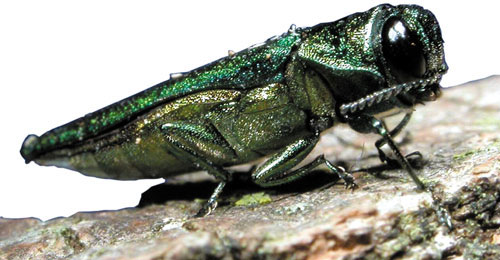
Emerald Ash Borer larvae on human hand. (Photo courtesy of Kansas Forest Service, Ryan Rastok) | Download this photo.
Emerald Ash Borer confirmed in 13 northeast Kansas counties
Kansas Forest Service urges early detection, treatment to save trees
July 7, 2023
By Pat Melgares, K-State Research and Extension news service
 MANHATTAN, Kan. – A Kansas Forest Service official has confirmed the presence of the Emerald Ash Borer in several northeast Kansas counties, and is advising landowners to be on the lookout for the beetle.
MANHATTAN, Kan. – A Kansas Forest Service official has confirmed the presence of the Emerald Ash Borer in several northeast Kansas counties, and is advising landowners to be on the lookout for the beetle.
Ryan Rastok, the forest health program coordinator for KFS, said EAB is capable of devastating white ash and green ash trees in rural and urban landscapes, where they provide shade for humans and cover for small wildlife.
At right: Damage revealed under tree bark from Emerald Ash Borer. | Download this photo
EAB was first suspected in the 1990s, though not detected or discovered until 2002. Since then, the beetle is responsible for the destruction of tens of millions of ash trees in 30 states (including more than 40 million in Michigan alone), according to the USDA’s Animal and Plant Health Inspection Service. The pest was first discovered in Kansas in 2012.
On July 7, Rastok reported infected trees in 13 Kansas counties: in alphabetical order, Atchison, Brown, Doniphan, Douglas, Franklin, Jackson, Jefferson, Johnson, Leavenworth, Miami, Osage, Shawnee and Wyandotte.
“I suspect it’s in other areas; we just haven’t found it (outside of the areas identified) yet,” Rastok said. “So we’re asking people – especially outside of those counties where we’ve currently found it – to let us know if they’re seeing dying ash trees. That’s extremely helpful for us to know that so that we can find (EAB) and we can give them information they need in real time to treat their trees.”
The Emerald Ash Borer – as its name suggests – is a green invasive, wood-boring beetle that kills ash trees by eating tissues under the bark. Adults are known to emerge in mid- to late-May from infestations to the trees the previous year, and lay their eggs shortly thereafter.
The resulting larvae bore into the ash tree and feed under the bark, leaving visible tracks underneath. Small trees can die as soon as 1-2 years after infestation, while larger infested trees may survive 3-4 years.
“Early in an infestation, trees can tolerate (EAB) for a few years, but when the population is at its peak, trees can be killed much more quickly,” Rastok said.
But Rastok says early detection and proper treatment can save infected trees. He recommends treatment as soon as possible by a licensed pesticide applicator; some of the options, he notes, include trunk injection, soil drench or bark spray.
“A trunk injection of Emamectin benzoate is effective for two – or in some cases, three – years, but the current best practice for that chemical is to re-inject every other year,” Rastok said. “All other treatment options would need to be re-applied annually.”
Rastok said he discourages homeowners from trying to treat infected trees themselves, noting that pesticides to do so are expensive, and the over-the-counter options are not as effective as treatments by a licensed applicator.
“If trees are not treated, they are going to die, plain and simple,” said Rastok, who notes that it may not be practical to treat several trees in a forest, where varieties may eventually build resistance.
“But it’s important to note that in urban areas, most of those varieties are cultivars, and cultivars are basically just genetic clones,” he said. “If you’re talking about a landscape tree that have been planted, I wouldn’t expect those to be resistant.”
Landowners who suspect an EAB infection should report it to the Kansas Forest Service by calling 785-532-3300, or send email to Rastok directly at rrastok@ksu.edu. Rastok also encourages sending pictures by email if you have detected a potential infection in a county not already identified as having EAB.
Kansans can also contact the Kansas Department of Agriculture’s plant protection and weed control program at 785-564-6700, or KDA.PPWC@ks.gov.


